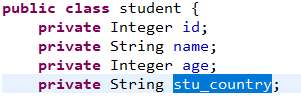(四)处理数据库与bean属性不一致情况
比如数据库的表结构:

bean结构:

在不修改表、bean结构基础上对映射文件进行修改即可(重命名)
一、在SQL中设置别名
stuCountry stu_country
<mapper namespace="test.studentMapper">
<select id="selectUserByID" parameterType="int" resultType="test.student">
select id,name,age,stuCountry stu_country from `tb_Student` where id = #{id}
</select>
</mapper>二、使用resultMap标签配置property属性和column属性的映射
注意此时用select *
<select id="selectUserByID" parameterType="int" resultMap="stu">
<!-- 当表和数据库属性不一致时,要重命名属性 -->
select * from `tb_Student` where id = #{id}
</select>
<resultMap type="student" id="stu">
<id property="id" column="id" />
<result property="name" column="name" />
<result property="age" column="age" />
<result property="stu_country" column="stuCountry"/>
<result property="stuHobbys" column="stu_Hobbys"/>
</resultMap>Q:mybatis是如何将SQL执行结果封装成目标对象并返回的?都有哪些映射形式?
第一种是使用<resultMap>标签,逐一定义数据库列名和对象属性名之间的映射关系
第二种是使用SQL列的别名功能,将列的别名书写成对象属性名
有了列名与属性名的映射关系后,mybatis通过反射创建对象,同时使用反射给对象的属性逐一赋值返回,那些找不到映射关系的属性,是无法完成赋值的

